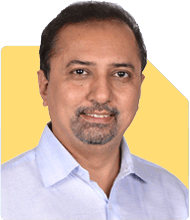Chandu Nair | Answer |Ask -Follow
VC, Angel Investing, Entrepreneurship Expert - Answered on Apr 15, 2023
He has direct experience in angel, venture capital and strategic investor funding. Over the last three decades, he has made a name for himself in industry, consultancy, media and information services.
Nair is on the advisory boards of the Chennai-based private equity firm Fulcrum and the social impact fund, Menterra. He's an independent director on the board of India's first retail building products company, Shankara Building Products Limited.
He was the co-founder of Scope e-Knowledge Center, a pioneering knowledge process outsourcing company, as well as the co-founder of a business-to-business e-commerce venture, both of which he successfully exited.... more

Dear Sir, I and my business partner started one IT company in 2019. After 6 months we started one E-commerce company and also registered that E-commerce company as a Private Company in 2021. From an IT company, I brought a business of nearly 2.5 lacs - 3 lacs from 2019 to 2021 as we were mostly in our other company. We have already given 3 years on our E-commerce still we have not got a single result and due to E-commerce, we couldn't focus on our IT company. For E-commerce, we have launched 2 soaps and 2 essential oils with our own brand and manufactured by 3rd party. E-commerce is a product based so it will take much time to promote the brand, needs to do marketing, etc. On E-commerce, we are just spending a lot but with no results. Right now both companies are loss-making. I want to focus more on IT company now because it is a service based company and we have created the portfolio as well by working for some of the clients before. I believe if we will focus more on the IT company now then we can get revenue as well as we can grow this company. With the grow of the IT company, we can also grow the other company as well. Sir, I want the best suggestion from you.
You may like to see similar questions and answers below
Harsh Bharwani | Answer |Ask -Follow
Entrepreneurship Expert - Answered on Apr 03, 2023
Harsh Bharwani | Answer |Ask -Follow
Entrepreneurship Expert - Answered on Apr 12, 2023
Nripen Bhatt | Answer |Ask -Follow
Start-Up Expert - Answered on Nov 07, 2024
Dr Dipankar Dutta |1836 Answers |Ask -Follow
Tech Careers and Skill Development Expert - Answered on Dec 05, 2025
Ulhas Joshi |280 Answers |Ask -Follow
Mutual Fund Expert - Answered on Dec 05, 2025
Dr Dipankar Dutta |1836 Answers |Ask -Follow
Tech Careers and Skill Development Expert - Answered on Dec 04, 2025
Ravi Mittal |676 Answers |Ask -Follow
Dating, Relationships Expert - Answered on Dec 04, 2025
Anu Krishna |1745 Answers |Ask -Follow
Relationships Expert, Mind Coach - Answered on Dec 04, 2025
Anu Krishna |1745 Answers |Ask -Follow
Relationships Expert, Mind Coach - Answered on Dec 04, 2025
Mayank Chandel |2562 Answers |Ask -Follow
IIT-JEE, NEET-UG, SAT, CLAT, CA, CS Exam Expert - Answered on Dec 04, 2025
Mayank Chandel |2562 Answers |Ask -Follow
IIT-JEE, NEET-UG, SAT, CLAT, CA, CS Exam Expert - Answered on Dec 04, 2025
Mayank Chandel |2562 Answers |Ask -Follow
IIT-JEE, NEET-UG, SAT, CLAT, CA, CS Exam Expert - Answered on Dec 04, 2025
Mayank Chandel |2562 Answers |Ask -Follow
IIT-JEE, NEET-UG, SAT, CLAT, CA, CS Exam Expert - Answered on Dec 04, 2025
























